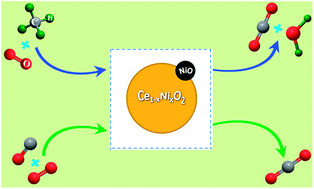Heterosturcture NiO/Ce1−xNixO2: synthesis and synergistic effect of simultaneous surface modification and internal doping for superior catalytic performance†
Abstract
In this work, a two-step method that involves a hydrothermal reaction and a subsequent calcination was initiated to prepare a novel heterostructure (1 − x)CeO2·xNiO. All samples were systematically characterized by X-ray diffraction, Raman spectra, Transmission electron microscopy, In situ DRIFT spectra, Brunauer–Emmett–Teller technique, H2-temperature-programmed-reduction, and O2-temperature-programmed-desorption. Distinct from the conventional sol–gel or co-precipitation methods, the present methodology allows Ni2+ to be simultaneously doped in the CeO2 lattice and dispersed onto the surfaces of CeO2 nanoparticles by simply varying the calcination temperature from 400 to 700 °C. When calcined at an optimized temperature of 500 °C, the heterostructure at x = 0.1 showed a mean grain size of 18 nm, specific surface area of 69.3 m2 g−1, the smallest lattice parameter, and the largest amount of surface adsorbed and desorped oxygen species, which has led to an excellent catalytic performance towards CO and CH4 oxidation. Such a superior performance benefits from the unique synergistic effects of the finely dispersed NiO and Ni–O–Ce solid solution species detected in the heterostructure.


 Please wait while we load your content...
Please wait while we load your content...